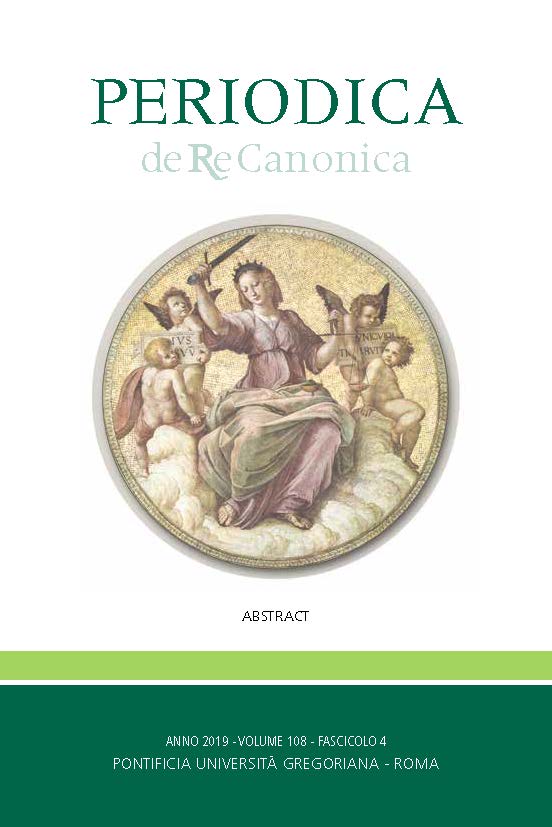Volume 108 - Issue 4
- Home
- Research and Publications
- Periodicals
- Periodica de Re Canonica
- Issues
- 2019
- Volume 108 - Issue 4

PERIODICA DE RE CANONICA - Fourth Issue 2019
Issue 108/4 (2019) of the magazine “Periodica de Re Canonica”, quarterly published by the Faculty of Canonic Law of the Pontifical Gregorian University, is now available.
 Ulrich Rhode, S.J., Decano della Facoltà di Diritto Canonico, Pontificia Università Gregoriana, Roma.
Ulrich Rhode, S.J., Decano della Facoltà di Diritto Canonico, Pontificia Università Gregoriana, Roma.
Some questions regarding the motu proprio De concordia inter Codices
Abstract - In 2016 pope Benedict XVI promulgated the motu proprio De concordia inter Codices in order to improve the harmony between the two Codes of the Catholic Church. After a brief introduction into the m.p., the article examines three types of questions:
Alan Modric’, S.J., Professore incaricato associato della Facoltà di Diritto Canonico, Pontificia Università Gregoriana, Roma.
The communion of the Roman Pontiff with the universal Church (can. 333 §2)
Abstract - The article explains how the communion of the Roman Pontiff with the universal Church can be effected (can. 333 §2), taking into consideration above all the sensus fidei of the God’s People, and through studying the Church bodies by which the realisation of such a communion is rendered possible.
Gianfranco Ghirlanda, S.J., Professore Emerito della Facoltà di Diritto Canonico, Pontificia Università Gregoriana, Roma.
The Apostolic Constitution Episcopalis Communio: Synod of Bishops and Synodality
Abstract - After demonstrating that within the magisterium of John Paul II there was an identification between synodality and collegiality, the author highlights that — in the teaching of Pope Francis — synodality concerns the whole Church, as a part of its «constitutive dimension», and that the collegiality of bishops is included within it. Therefore, the sensus fidei of the faithful assumes a new importance: the totality of the faithful, united to their pastors, cannot make mistakes in their belief. Through this perspective, the Church appears both as an inverted pyramid and as a communion of concentric circles. The Synod of Bishops, in its new structure, implements this synodality within the consultative/preparatory phase of the People of God through the organs of participation in the particular and local Church: in the preparatory phase (by means of discussion and discernment), as well as in the implementation phase. Relevant ecumenical repercussions of this same reform of the Synod of Bishops and possible developments are also shown.
Damián G. Astigueta, S.J. Professore Ordinario della Facoltà di Diritto Canonico alla Pontificia Università Gregoriana. The Sentence, Certitude, and Motivation in a Penal Process
Abstract - The process as an action of the Church must always contribute to rebuilding the fabric of the community as well as to the salvation of the souls of all those involved in the cause (both of the parties and of the members of the court). Therefore, a sentence must be an expression of the truth and, as such, must be communicable to the parties as a testimony of the truth which was brought to light by the evidence. For this reason, the Legislator wanted to give a fundamental value to evidence, as well as to indicate that a sentence given by a judge must be founded on moral certitude.